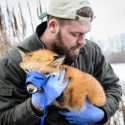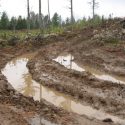Fighting the Grinch who stole Wisconsin’s Christmas trees
For Wisconsin Christmas tree farmer Dan Hanauer Jr., the Grinch is very real. It lurks in his soil, greedily munching on the roots of his trees and stealing his chances for a profitable holiday season.

“One year, we planted about 50,000 trees and we lost all of them. That kind of loss tends to get your attention.”
“This thing can just devastate a field,” says Hanauer, who grows trees on 500 acres near Shawano. “One year, we planted a new 50-acre field, which is about 50,000 trees, and we lost all of them. That kind of loss tends to get your attention.”
It’s not a green-skinned ogre causing such Grinchly havoc, but a tiny, cream-colored grub from the beetle family Scarabaeidae. A larval form of the common May/June beetle, these grubs spend nearly three years underground, feasting on the roots of trees, grasses and other plants before emerging as winged adults. A single grub can devour a young tree’s entire root system, essentially choking it from the bottom up.
That makes the scarab grub a big problem around Wisconsin, which grows more Christmas trees than all but four states. Some 1,100 Christmas tree farmers operate in the state, and as many as one-third deal with persistent damage from grubs, says Chris Williamson, an associate professor of entomology at UW–Madison and an extension specialist on insect control.
Despite the insects’ prevalence, few guidelines exist to help growers like Hanauer deal with them. “If you go into the literature, there’s really nothing about management practices for this insect in Christmas trees. It just hasn’t been studied in this system,” says Williamson.
UW-Madison graduate student P.J. Liesch is working to change that. For the past two summers, Liesch has studied nearly 1,000 Fraser fir trees around Hanauer’s farm to experiment with cultural, biological and chemical methods of dealing with the grubs. The project, which was sparked when a frustrated Hanauer contacted Williamson to help explain the crippling losses on his farm, has raised hopes among state tree farmers that a proven plan of attack will emerge.
“There are a lot of anecdotal stories out there about things that work, but they really haven’t been tested,” says Liesch. “The goal is to find some strategies that are effective and environmentally responsible in this system.”
Part of Liesch’s work examines insecticides used to ward off grubs in other systems, such as turfgrass. The early data suggest that some of those products, chiefly ones with the active ingredient imidacloprid, can be effective in reducing grub populations around trees. In Liesch’s trials, insecticides reduced tree losses to less than 15 percent in infested fields, compared to losses exceeding 90 percent without treatment.
But trees present some unique challenges. Unlike turf, few tree farms are irrigated, meaning that insecticides may not reach the depth where grubs live unless they are applied directly to roots, a costly and labor-intensive process. Christmas trees also typically grow for 10 years or more before harvest, and since a tree’s susceptibility to grubs declines with age, it wouldn’t make sense to treat every tree in the field the same.
“There’s no one thing that you can do consistently,” says Hanauer, whose farm has been in the family since 1966. “There’s just no magic bullet.”
Liesch’s research isn’t likely to provide one, but it will give growers better data about the need for and timing of treatments, as well as alternative approaches that could supplant or reduce chemical applications. Liesch has examined the effectiveness of introducing grub-eating nematodes to help suppress the insects’ population, which he says shows modest results in certain circumstances. He and Williamson also stress the importance of understanding the population dynamics of the grubs, which tend to boom in three-year cycles, making those years most critical for intervention.
That knowledge helped Hanauer adopt a tiered-strategy that employs three different insecticides at specific stages during his trees’ growth. And while he says battling the bothersome bug is still “a war of attrition,” he’s grateful to have some science on his side.
“My hope is that we find some strategies that work for the whole industry,” he says. “But from my perspective, just having contact with the researchers has been really valuable. Every time I talk with them I learn something.”



